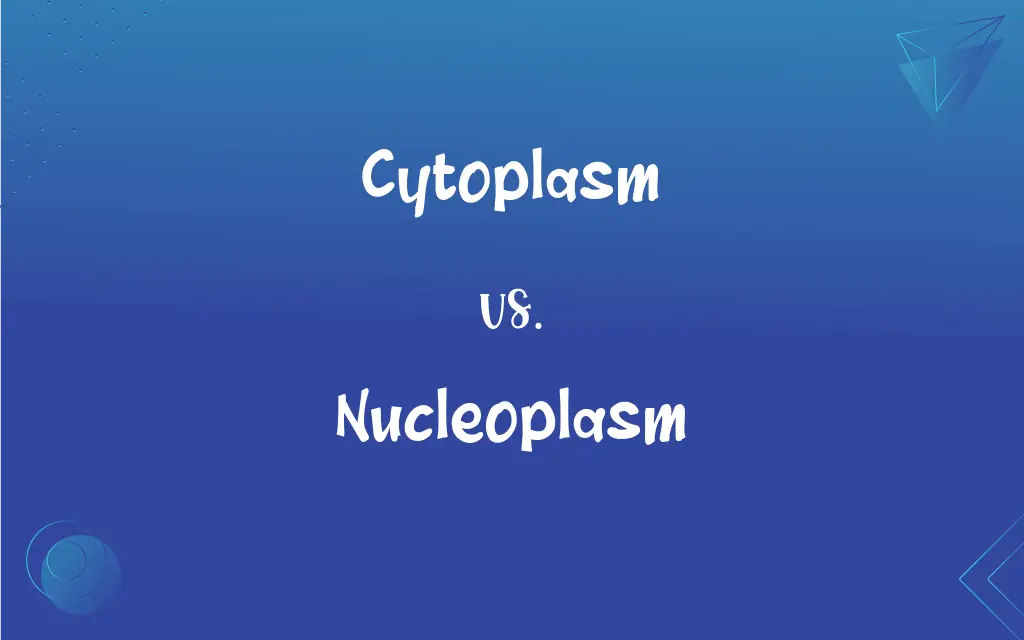Cytoplasm vs. Nucleoplasm: What's the Difference?
Edited by Janet White || By Harlon Moss || Updated on October 28, 2023
Cytoplasm is the cell's fluid outside the nucleus, while nucleoplasm is the fluid inside the nucleus.

Key Differences
Cytoplasm constitutes the gel-like substance residing between the cell membrane and the nuclear envelope. This component holds cellular organelles and is essential for various cell activities. On the contrary, nucleoplasm, also known as karyoplasm, is situated inside the nucleus and encompasses the chromosomes and nucleoli.
Cytoplasm plays a crucial role in maintaining the cell's shape and harbors many metabolic reactions. It consists of water, salts, and various organic molecules. Nucleoplasm primarily serves to cushion and protect the nucleus's contents and is rich in enzymes, nucleotides, and a range of other essential molecules.
While both the cytoplasm and nucleoplasm are gel-like, their viscosities might differ. The cytoplasm often showcases a more granular appearance due to the myriad of organelles it contains. The nucleoplasm, on the other hand, is more consistent, mainly reflecting the presence of chromatin.
Cytoplasm provides the site for many cellular processes, from glycolysis to protein synthesis that occurs on ribosomes. Nucleoplasm, being inside the nucleus, is pivotal for processes related to DNA and RNA, such as replication, transcription, and RNA processing.
Both cytoplasm and nucleoplasm play roles in the cell's response to environmental changes. For example, the consistency of the cytoplasm might change under certain conditions, affecting cell movement. Similarly, alterations in the nucleoplasm can influence gene expression and the cell's overall behavior.
ADVERTISEMENT
Comparison Chart
Location
Between cell membrane and nuclear envelope
Inside the nucleus
Function
Maintains cell shape, metabolic reactions
Cushions and protects nuclear contents
Composition
Water, salts, organic molecules, organelles
Enzymes, nucleotides, chromatin
Processes Occurring
Glycolysis, protein synthesis
DNA replication, transcription, RNA processing
Appearance
Granular due to organelles
Consistent due to chromatin
ADVERTISEMENT
Cytoplasm and Nucleoplasm Definitions
Cytoplasm
A mixture of water, salts, and organic molecules.
The cytoplasm's composition ensures the cell's proper functioning.
Nucleoplasm
Also known as karyoplasm, it cushions nuclear contents.
The nucleoplasm ensures that genetic material remains intact.
Cytoplasm
The medium where cellular organelles reside.
The mitochondria, found in the cytoplasm, produce energy for the cell.
Nucleoplasm
The medium where chromatin and nucleoli are located.
Within the nucleoplasm, genes get transcribed into RNA.
Cytoplasm
The site for numerous metabolic reactions in a cell.
The enzymes in the cytoplasm drive vital reactions like glycolysis.
Nucleoplasm
The fluid found inside the nucleus of a cell.
The nucleoplasm surrounds the chromosomes, providing a protective environment.
Cytoplasm
Essential for maintaining the cell's structural integrity.
Without cytoplasm, cells would collapse and lose their shape.
Nucleoplasm
Rich in enzymes and nucleotides for DNA/RNA processes.
Replication requires enzymes present in the nucleoplasm.
Cytoplasm
The fluidic component between the cell membrane and nucleus.
Organelles are suspended within the cytoplasm, facilitating cellular processes.
Nucleoplasm
Essential for nuclear processes and gene regulation.
Alterations in the nucleoplasm can influence a cell's genetic activities.
Cytoplasm
The protoplasm enclosed by the plasma membrane of cell, excluding the nucleus in eukaryotic cells and cellular DNA in prokaryotic cells.
Nucleoplasm
The protoplasm of a cell nucleus. Also called karyoplasm.
FAQs
Can a cell function without cytoplasm?
No, cytoplasm is essential for the cell's metabolism and structure.
Where is the cytoplasm located in the cell?
The cytoplasm is located between the cell membrane and the nuclear envelope.
Does the nucleoplasm contain DNA?
Yes, the nucleoplasm encompasses the cell's chromatin, which contains DNA.
Can the nucleoplasm's composition change?
Yes, it can vary based on the cell's activities and needs.
What is the primary role of nucleoplasm?
The nucleoplasm cushions and protects the contents of the nucleus.
What gives the cytoplasm its gel-like consistency?
The cytoplasm consists of water, salts, and organic molecules, giving it a gel-like texture.
How does the cytoplasm respond to environmental changes?
It can change in consistency and composition, affecting cell processes.
Do prokaryotic cells have cytoplasm?
Yes, prokaryotic cells have cytoplasm but lack a defined nucleus.
How do substances enter and exit the cytoplasm?
Through the cell membrane via various transport mechanisms.
What gives the cytoplasm its color?
It is mostly translucent, but organelles and solutes can impart a slight color.
Are there any diseases associated with cytoplasmic defects?
Yes, some diseases can arise due to abnormalities in cytoplasmic components.
How does the cytoplasm aid in cellular communication?
It contains signaling molecules and pathways facilitating communication.
Is the nucleoplasm similar in all cell types?
While the basic function remains the same, its composition can vary depending on the cell type.
Do the cytoplasm and nucleoplasm ever mix?
They remain separate due to the nuclear envelope acting as a barrier.
How does the cytoplasm interact with organelles?
Organelles are suspended in the cytoplasm and carry out their functions there.
Is nucleoplasm unique to eukaryotes?
Yes, only eukaryotic cells have a nucleus with nucleoplasm.
Is nucleoplasm present in all cells?
Nucleoplasm is present in all eukaryotic cells with a defined nucleus.
How does the nucleoplasm support chromosomal activities?
It provides the enzymes and molecules necessary for DNA replication and RNA synthesis.
Can substances move freely within the nucleoplasm?
Yes, molecules like enzymes and nucleotides can diffuse within the nucleoplasm.
What would happen if the nucleoplasm was removed from a cell?
The nucleus would lose its structure, and nuclear processes would be disrupted.
About Author
Written by
Harlon MossHarlon is a seasoned quality moderator and accomplished content writer for Difference Wiki. An alumnus of the prestigious University of California, he earned his degree in Computer Science. Leveraging his academic background, Harlon brings a meticulous and informed perspective to his work, ensuring content accuracy and excellence.
Edited by
Janet WhiteJanet White has been an esteemed writer and blogger for Difference Wiki. Holding a Master's degree in Science and Medical Journalism from the prestigious Boston University, she has consistently demonstrated her expertise and passion for her field. When she's not immersed in her work, Janet relishes her time exercising, delving into a good book, and cherishing moments with friends and family.
































































